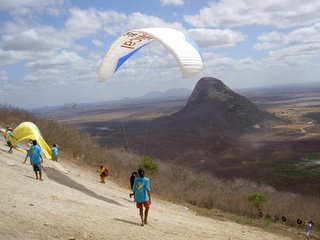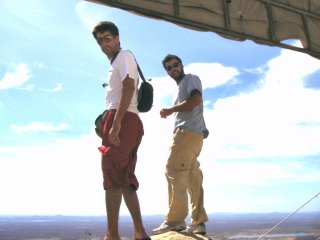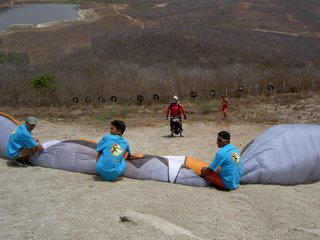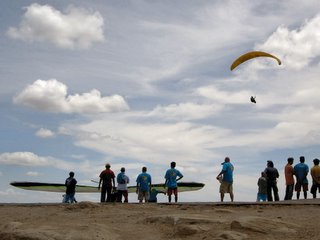 Quixadá, 18th November 2005
Quixadá, 18th November 2005When we got down to breakfast (always plentiful: we never knew when we ate again) at the hotel the area was already very busy, for it was the last competition day, and the result was still open. We already had two flights excluded and this should be the decisive day.
The first car went to the take-off by 7h15 and I boarded the next by 7h30.
On our way I observed a pilot already in the air, circa 7h45; he was not Francisco Ceará as usual but could not identify him, I was concentrated on Bret and Tomas.
I was feeling a great pressure because I had been on the first place at first and now had slipped to third with great pilots ahead: Bret Zaenglein from the US and Tomas Brauner from the Czech Republic. Although our classification di
 fferences were small I was in a disadvantage and needed to ponder very carefully my decisions.
fferences were small I was in a disadvantage and needed to ponder very carefully my decisions.I was ready to take off by 9h and it was what Tomas did, when some five pilots were already flying.
I analysed the wind cycles and noted some good windows to take-off: 20-30kmh during less than a minute then increased rapidly to 50kmh.
Although being on the ground, the take-off is the moment of the flight that demands the most attention and care, it is very stressful and does not allow mistakes due to the aggressive wind conditions. There are some references to observe in the process: the gusts on the lake in front, the shaking bushes, the clouds that come over and produce ample shade on the ground in front and over the take-off allowing the reduction of the wind intensity. Just when these factors are m
 ore or less combined favourably we would encounter minimal safe conditions to take-off. Very often this process imposes a long waiting time.
ore or less combined favourably we would encounter minimal safe conditions to take-off. Very often this process imposes a long waiting time.With the indispensable help of the Juatama kids (the town close to the take off) I took off at 9h12, after Petra Krausova and Gilmar Couto. Tomas was already high and Bret was preparing for take-off.
I decided to take-off in between because I thought I could bette
 r control them. This wind cycle had been suitable to take off but bad to climb: I had to wait a long time in front of the take-off. Then came a thermal but very slanting which did not allow me to return any more. I then countered the thermal’s direction to the north over Quixadá’s lagoon, something that was not usual but I saw most pilots on the route axis flying very low.
r control them. This wind cycle had been suitable to take off but bad to climb: I had to wait a long time in front of the take-off. Then came a thermal but very slanting which did not allow me to return any more. I then countered the thermal’s direction to the north over Quixadá’s lagoon, something that was not usual but I saw most pilots on the route axis flying very low.Next I felt at risk, the ceiling was still low (1300m), the usual cumulus were scarce and the wind was braking the thermals.
Although flying low I started relatively fast, I had to wind near zeros, falling onto a descendent would be the artist’s death, I could not afford searching the thermals’ nuclei.
Then I got a serious problem: my radio’s batteries went flat and although I had a spare one I could not change it. From now on I could not control anyone and worse, I would not be able to transmit my position. Due to safety and logistical reasons the pilots should report periodically their position and distance from the set waypoints.
Since this moment in my flight I just had to concern with myself and try to ignore the other two
 pilots although I had the feeling that they would not be far around.
pilots although I had the feeling that they would not be far around.Only at km 50 I was finally able to reach the base at 1800m, then it was very
 straightforward for the next 50k, fast and easy under a wonderful cumulus street with good formations and strong thermals, the day seemed to be improving a lot.
straightforward for the next 50k, fast and easy under a wonderful cumulus street with good formations and strong thermals, the day seemed to be improving a lot.But… no, I got low down again! It is a difficult section between km 100 and km 150: there is a chain of mounts that start with hills that grow upto mountains. These mountains are normally negotiated on the north side, but “cricket clouds” showed the conditions to have deteriorated and the thermals came up in swirls.

We were three pilots in misery, two paragliders and one delta. I searched for the venturi of one of these mounts and survived drifting a great deal and climbing very little towards the chain’s centre where some small cumuli provided the sign that the base should be a little higher than elsewhere.
While flying over these mounts I reckon Bret flying very low, more or less at my position, and seemed having no chance to recover (100k). Only Tomas was missing.
While flying high in the midst of this chain I suddenly detected a paraglider trying to soar on a crest at the lee of this mountain chain: that was he!

Without being 100% sure that it was Tomas I abandoned the competition route (270º) to a more southerly direction (225º) where I betted that a confluence would exist formed by the wind that became divided by the mountain and this mass would rejoin at the lee side. I hoped that it would form an ascendancy line for many quilometers. The stronger the wind on the ground, the longer this ascendancy line becomes.
I continued low and observed Miguel Costa high over me, but in a short time I climbed from 780m to 2820m and saw him and Tomas at a distance and kept flying on this confluence. After this, I saw no one during the remainder of the flight.
At 13h20, lunchtime, I was at km 180 and against my habit I ate some cereal bars and drank hydration fluid.
The plain was long unto km 210 but with a sequence of well-chained cycles it was easy.
I then reached the famous Ibiatapa mountain chain that is 150k long perpendicular to my route and on which I could see various wildfires.
If on one hand the ceiling goes up over the mountains and benefits me, on the other the fires were troubling me because there was no clouds on the plateau after the chain.

I decided not to correct my route and kept slightly southerly (225º) relatively to the competition axis (270º) trying to follow the path of my first flight this week, which also took me far (279k).
It worked, cycle after cycle, my worry now was to keep flying no matter in which direction because I knew that many pilots would land on this 30k long plateau.
At this stage I decided that I really needed to apply the “number one rule” of cross country flying: keep flying no matter in which direction!
Willing to fly fast or trying to keep on the established route could put at risk all my today’s work.

By 15h20 I was passing km 280 exactly over the place where I landed the first day. I am one hour earlier and I still have two hours to fly.
At this moment I start believing that it can happen!
Without hesitation I started a 40k traverse where the vegetation is dense but greener than previously. It is called jurema and is, in many pilots’ opinion, an enormous source of heat: it is composed of semi-dry branches that do not project shade on the ground and constitute a barrier against the wind, keeping the heat concentrated on the ground.

However it now had become greener and I needed to avoid it and search for shallower ground which was a difficult task because all around seemed very uniform.
From now on the company of the local preying birds, the urubus, was precious to keep flying: the sun was now shining from the south (right into my face) making it very difficult to study the terrain and the clouds were scarce.
By mid afternoon I was conscious that I needed to eat and drink again to keep the high concentration level – I had been flying for almost seven hours.
Without towns around I imagined that landing here would mean many hours walk and probably spending the night in the bush.
I entered a thermal, which would probably be the last one and winded it with a great deal of patience, and with no anxiety I reached 3000m for the first time.
It was 16h55 and had flown 340k.

I engaged the last glide with the wind on my back with an average finesse of 15 and crossed the main road of the state (Piauí) when I noticed that some cars were already circulating with their headlights on (at 3000m we enjoy much stronger daylight than on the ground).
I reached the small town of Cabeceira (it is in Garmin 76S’s map) at km 370 and still had 800m over the ground.

Here I had a difficult decision to take: either land here or continue over a forest of palm trees and other high trees.
I knew that the south American record was 377k so landing here was excluded and went on…
Now full of anxiety I almost could not take my eyes from the gps counting every 100m.
I ceased caring, if I would not break the record one these palm trees would stop me.
It was finally with 381k flown that I turn to the wind and land on a crossing of trails in the middle of nowhere.
Without knowing exactly what to do I noticed that darkness was approaching and rapidly folded my glider ending the task with a flashlight on my hand.
Suddenly some children and adults came over. They had seen me from their hamlet and followed the flight path. I was afraid at first for I did not know how they would react.

I told them that I was lost and needed help.
Soon they showed willingness to help and called a man who kindly drove me to the town in his old car. Speaking the same language was crucial.
Luckily I was able to call Chico Santos, the competition director, from this town. He was worried due to my lack of contact but very happy and confirmed that I had broken the record. He also informed that I would not be met that day but only on the following and that I should find a place to sleep.

I found lodging in the sole possibility, the lodge “Lake Breeze”. It had a patio with various cloth hammocks and two rooms at the back, one of which was free.
At 10h next morning my transport arrived and I could not imagine the ordeal that I would go through the entire daylong, very tough.
I reached Quixadá at 23h, 30.5h after landing!
Diogo Pires
PS: The results of XCeará 2005.








